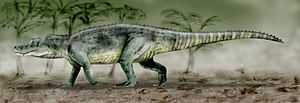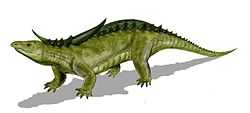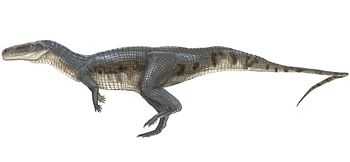Saurosuchus
| Saurosuchus Temporal range: Late Triassic, 231.4Ma | |
|---|---|
| | |
| Mounted skeleton of Saurosuchus galilei in the Ischigualasto Provincial Park | |
| Scientific classification | |
| Kingdom: | Animalia |
| Phylum: | Chordata |
| Class: | Reptilia |
| Clade: | Loricata |
| Genus: | †Saurosuchus Reig, 1959 |
| Type species | |
| Saurosuchus galilei Reig, 1959 | |
Saurosuchus (meaning "lizard crocodile" in Greek) is an extinct genus of rauisuchian archosaur in the family Prestosuchidae. With a length of around 7 m (23 ft), it was the largest rauisuchian, except perhaps for the less well known Fasolasuchus. Like other rauisuchians, Saurosuchus walked on four fully erect limbs. It lived in the Late Triassic of Argentina.
Description
Saurosuchus is one of the largest rauisuchians. The complete skeleton is not known and size estimates range from around 6 to 9 metres (20 to 30 ft) in total body length.[1][2] Dorsal osteoderms run along the back of Saurosuchus.[3] There are two rows to either side of the midline, with each leaf-shaped osteoderm joining tightly with the ones in front of and behind it.[2]

Skull
It has a deep, laterally compressed skull. The teeth are large, recurved, and serrated. The skull is wide at its back and narrows in front of the eyes. The skull roof and maxilla are somewhat pitted, a distinguishing feature not seen in any other rauisuchian. Pitting is also seen in aquatic phytosaurs and crocodilians, but the ridges and grooves are deeper and much more extensive across the skulls of these forms. The frontal bones, located at the top of the skull, are enlarged to form thick ridges over the eyes. As in other rauisuchians, a small rod projects down from the lacrimal bone in front of the eye, but it does not attach firmly to the jugal bone below it. Ridges along the upper surface of the supraoccipital bone at the back of the skull are attachment points for strong neck ligaments.[1] The cervical vertebrae are shortened and robust, forming a strong neck.
Discovery

Saurosuchus is known from several partial skeletons collected from the Ischigualasto Formation of Argentina. The holotype specimen consists of a complete but deformed skull, dorsal vertebrae, dorsal osteoderms, and parts of the pelvis. The hind limbs, tail, neck, and scapulae are also represented in several other skeletons.[3][1] The type species S. galilei was named in 1959. Saurosuchus was also reported from the Chinle Formation of Arizona in 2002 on the basis of isolated teeth and small skull fragments.[4] The diagnostic value of these bones has been questioned in later studies, which considered them to be from an indeterminate species of rauisuchian.[5]
References
- ↑ 1.0 1.1 1.2 Alcober, O. (2000). "Redescription of the skull of Saurosuchus galilei (Archosauria: Rauisuchidae)". Journal of Vertebrate Paleontology 20 (2): 302–316. doi:10.1671/0272-4634(2000)020[0302:ROTSOS]2.0.CO;2.
- ↑ 2.0 2.1 Sill, W.D. (1974). "The anatomy of Saurosuchus galilei and the relationships of the rauisuchid thecodonts" (PDF). Bulletin of The Museum of Comparative Zoology 146: 317–362.
- ↑ 3.0 3.1 Trotteyn, M.J.; Desojo, J.; Alcober, O. (2011). "Nuevo material postcraneano de Saurosuchus galilei (Archosauria: Crurotarsi) del Triásico Superior del centro-oeste de Argentina". Ameghiniana 48 (1): 13–27. doi:10.5710/amgh.v48i1(265).
- ↑ Heckert, A.B.; Lucas, S.G.; Krzyzanowski, S.E. (2002). "The rauisuchian archosaur Saurosuchus from the Upper Triassic Chinle Group, Southwestern U.S.A., and its biochronological significance" (PDF). In Heckert, A.B.; and Lucas, S.G. (eds.). Upper Triassic Stratigraphy and Paleontology 21. New Mexico Museum of Natural History and Science Bulletin. pp. 241–247.
- ↑ Irmis, R.B. (2005). "The vertebrate fauna of the Upper Triassic Chinle Formation in Northern Arizona" (PDF). In Nesbitt, S.J.; Parker, W.G.; and Irmis, R.B. (eds.). Guidebook to the Triassic Formations of the Colorado Plateau in northern Arizona: Geology, Paleontology, and History 9. Mesa Southwestern Museum.
External links
| Wikimedia Commons has media related to Saurosuchus. |
| ||||||||||||||||||||||||||||||||||||||||||||||||||||||||||||||||||||||||||||||||||||||||||||||||||||||||||||||||||||||||||||||||||||||||||||||||||||||||||||||||||||||||||||||||||||||||||||||||||||||||||||||||||||



